 This small petroglyph site in southern Morocco has – despite its limited number of decorated panel – a rather large variety of images. There are petroglyphs of quadrupeds (felines, bovines, antelopes, an elephant, perhaps a goat), some birds (probably ostriches) and one simple, yet interesting petroglyph of an outlined anthropomorphic figure. The site is very easily accessible and thus suffers from vandalism.
This small petroglyph site in southern Morocco has – despite its limited number of decorated panel – a rather large variety of images. There are petroglyphs of quadrupeds (felines, bovines, antelopes, an elephant, perhaps a goat), some birds (probably ostriches) and one simple, yet interesting petroglyph of an outlined anthropomorphic figure. The site is very easily accessible and thus suffers from vandalism.
By Maarten van Hoek
*
*
Petroglyphs of Tourirt-n-Tislatine
Southern Morocco
Maarten van Hoek
Click any illustration to see an enlargement
*
Introduction
Morocco is not only known for its beautiful landscapes, but also for its numerous rock art sites that are often found concentrated in pockets in the High Atlas and in its contact zone with the Sahara south of the Atlas Mountains. Especially the areas near and the drainages passing through the many natural breaches (foums) in the Jebel Bani mountain ridge have many rock art sites. The river valleys most likely provided suitable through routes from the Anti-Atlas to the contact zone with the Sahara (Figure 1).
Figure 1. Location of Tourirt-n-Tislatine, southern Morocco. Map © by Maarten van Hoek, based on the map © by OpenStreetMap – Contributors.
Fine examples are the rock art complexes near the foums of Akka, Icht (Figure 1) and Taghjijt. The group of petroglyph sites of Taghjijt is found in a roughly triangular, rather flat area (the Feija Taghjijt) with the village of Amtoudi at its apex in the north and the east-west running (dry) river of the Wadi Eç Çayyad (or Oued Seyad) at the base of the triangle (Figure 2). In this area no less than 36 rock art sites and sub-sites have been recorded. One of those rock art sites is Tourirt-n-Tislatine (ST-F2), situated only a short distance west of the dry river bed of Assif Kelmt, also known as Assif-n-Kelmt, Assif m’Kelmt, Oued Kelmt, Oued Klem and even as Assif n’Olimi.
Figure 2. Location of Tourirt-n-Tislatine (the large green square), southern Morocco. Map © by Maarten van Hoek, based on the map © by OpenStreetMap – Contributors.
*
The Location of Tourirt-n-Tislatine (ST-F2)
The modest rock art site of Tourirt-n-Tislatine (ST-F2; large green square in Figure 2) is located at the apex of the extensive plain of the Feija Taghjijt, a vast plain that is dotted with rocky ridges and isolated hillocks. The Feija is bordered by higher hills and ridges and, especially to the north, by the higher mountains of the Anti-Atlas. At the very apex the village of Amtoudi and its impressive agadirs (fortified granaries) seem to control access to the Anti-Atlas via a narrow gorge. The rock art site of Tourirt-n-Tislatine (ST-F2) – an isolated rocky hillock (Figure 3) – is located about 4 km SW of Amtoudi, roughly 88 km inland (see Figure 1), and at an altitude of about 820 m above sea-level. About 790 m to the SSE is the rock art site of Assif Kelmt (ST-H1) also surveyed by us in 2019, while a review of Assif Kelmt (ST-H1) was published by me somewhat later (Van Hoek 2020). This short paper offers an impression of the rock art site of Tourirt-n-Tislatine (ST-F2) also known as Taourirt-n-Tislatine.
Figure 3. Tourirt-n-Tislatine, looking NW. The rock art is hidden at the other side of the hill. Photograph © by Maarten van Hoek.
*
Tourirt-n-Tislatine: One or Two Sites? A Short History
It is certain that local people were the first to notice the ancient rock art at Tourirt-n-Tislatine, but it took a long time before the site was finally revealed to the scientific world. Rock art researcher André Simoneau was probably the first scholar to publish some modest information about a site he called “Assif Kelmt” (1977). In his book Simoneau also included one photograph of an elephant petroglyph allegedly found “at Assif Kelmt” (1977: Planche 46; his photo should be flipped horizontally). Unfortunately, at a later stage his publication created some confusion regarding the site name. To start with, only one year later, Richard Wolff (1978: 187) discussed a group [of elephants] on the flat bank of the Assif Kelmt having bowl-shaped feet, simultaneously referring to the photograph by Simoneau (1977: P. 46), but the description by Wolff of a flat bank can only refer to the site of Assif Kelmt (ST-H1) on the east bank of the dry river bed.
It was Alain Rodrigue (2009: 225) who – many years later – correctly remarked that the elephant petroglyph (see Figure 10) that Simoneau listed as “Assif Kelmt” is found at the rock art site of Tourirt-n-Tislatine on the west bank of the Assif Kelmt. Thus the site of “Assif Kelmt”, as labelled by Simoneau, proved to be a different site altogether located on the west bank, some 790 m NNW of the actual site of Assif Kelmt (ST-H1, which is found on the eastern bank). Therefore, it is uncertain whether the site of Tourirt-n-Tislatine that Simoneau listed in his inventory as Site Nr. 150.189 also included Assif Kelmt (ST-H1).
A year later Rodrigue published a solid paper on the rock art of Taghjijt in which he stated (2010: 142) that the elephant petroglyph of which a photograph was published by Simoneau (1977: Planche 46) was found “at Assif Kelmt”. This site was consequently listed as Station 8 by Rodrigue (2010: 141), not mentioning however the difference between the two rock art sites at that spot. Perhaps at that time the numbering system (ST-XX etc.) that is in use now, was not introduced yet. The rock art site labelled “Assif Kelmt” by Simoneau (1977 – 150.189) and as ‘Site 8’ by Rodrigue (2010) – the site where the elephant petroglyph (see Figure 10) is found – proved to be the site on the west bank, which is known as Tourirt-n-Tislatine (ST-F2).
In 2001/2004 Susan Searight published an important and extensive thesis about Moroccan rock art. She listed a rock art site at Assif Kelmt as her Site S-88. However, she added the number used by Simoneau (1977 – 150.189; which in fact refers to Tourirt-n-Tislatine) simultaneously (and thus confusingly) stating that the site was located on the left (eastern) bank of the river (2001: 306), which refers to Assif Kelmt (ST-H1). It thus seems that the site of Tourirt-n-Tislatine (ST-F2) was not included in the thesis by Susan Searight.
*
Provisional Inventory
This provisional (and most likely incomplete) inventory will first describe all nine panels that we have surveyed at Tourirt-n-Tislatine, briefly describing the petroglyphs. Most of the petroglyphs are found on rather large boulders detached from the north side of the rocky hillock (see Figure 9). As there proved not to exist a numbering system regarding the several panels, I hereby introduce my own numbering system (ST-F2-001 etc.) for easy reference. All anthropic markings, no matter what their age is, will be included, but amorphous groups of (possibly) anthropic pecking and panels with only scratching (including the instances of recent vandalism) will be ignored, as will all natural features, like small depressions. Because of lack of time it was not attempted to make a plan of the site. Therefore, the following register must not be regarded as an official, scientific inventory. Scales are not provided (only some estimated measurements), nor are the exact bearings of the decorated panels mentioned. The nine decorated boulders – all arranged along the northern base of the hillock – will roughly be described from west to east. Of course further investigations may yield more decorated panels and/or more images.
*
Boulder ST-F2-001: Not published previously (as far as I know) is the easternmost boulder (or outcrop block?) projecting from the rocky wall. It bears the outlined petroglyph of a quadruped (its bottom end apparently unfinished). It most likely depicts a bovine featuring one clearly forward curving horn and one faint ear (Figure 4). There is also some recent damage and vandalism (especially in front of the head).
Figure 4. Boulder ST-F2-001 at Tourirt-n-Tislatine, southern Morocco. Photograph © by Maarten van Hoek.
*
Boulder ST-F2-002: This boulder is the most interesting of the site. A drawing of its petroglyphs was published by Alain Rodrigue in 2010 (Rodrigue 2010: Fig. 4.3; Figure 6). Unfortunately the smooth, undulating surface makes it difficult to simultaneously photograph all three images clearly (Figures 5 and 6). The images – all outlined – comprise (from top to bottom): a left-looking quadruped (Figure 7), which most likely depicts a goat with apparently two horns (only one drawn by Rodrigue; the left-hand horn running the risk of flaking off); a right-looking quadruped with a long, thin, curving tail (possibly a feline); and attached by a single straight line from the purported “feline”, a frontally depicted anthropomorphic figure (Figure 8) with both its arms raised (an orant?). For scales see Rodrigue 2010.
Figure 5. Location of Boulders ST-F2-002, 003 and 004 at Tourirt-n-Tislatine, southern Morocco. Photograph © by Maarten van Hoek.
Figure 6. Boulder ST-F2-002 at Tourirt-n-Tislatine, southern Morocco. Photograph © by Maarten van Hoek. Drawing © by Maarten van Hoek, based on the drawing by Alain Rodrigue (2010: Fig. 4.3).
Figure 7. The purported goat petroglyph on Boulder ST-F2-002 at Tourirt-n-Tislatine, southern Morocco. Photograph © by Maarten van Hoek.
Figure 8. The anthropomorphic figure petroglyph on Boulder ST-F2-002 at Tourirt-n-Tislatine, southern Morocco. Photograph © by Maarten van Hoek.
*
Boulder ST-F2-003: This boulder is found further east (Figure 9) and has two decorated panels. Panel A: The “north” facing panel has the petroglyph of the elephant (Figure 10A) recorded by Simoneau (1977: Planche 46; photo should be flipped horizontally) and – above the elephant – the image of a quadruped (most likely a [male?] bovine). Both animals are outlined and look to the right (east). The bovine (Figures 10B and 11) has internal decoration; the area marked in red in Figure 10B also seems to have been fully pecked (not shown in the drawing by Rodrigue). Unfortunately the panel is heavily vandalised by pecking and scratching (Figure 10). Panel B: This hard to photograph panel (also vandalised) has at least one petroglyph of a quadruped, most likely a (male?) bovine. It has two horns; one curved above the head, the other curved forward across the head. Interestingly, the two front legs are connected by a short groove. This may depict the practice of tying the front legs together in order to prevent the animal to go astray (Figure 12). Below the quadruped are possibly more very faintly visible petroglyphs.
Figure 9. Location of Boulders ST-F2-003 and 004 at Tourirt-n-Tislatine, southern Morocco. Photograph © by Maarten van Hoek.
Figure 10. Boulder ST-F2-003 – Panel A at Tourirt-n-Tislatine, southern Morocco. Photograph © by Maarten van Hoek. Drawing © by Maarten van Hoek, based on the drawing by Alain Rodrigue (2010: Fig. 4.3). Scales: see Rodrigue 2010.
Figure 11. Detail of the bovine on Panel A of Boulder ST-F2-003 at Tourirt-n-Tislatine, southern Morocco. Photograph © by Maarten van Hoek. Scales: see Rodrigue 2010.
Figure 12. Panel B of Boulder ST-F2-003 at Tourirt-n-Tislatine, southern Morocco. Rough sketch (possibly inaccurate) © by Maarten van Hoek.
*
Boulder ST-F2-004: Not published previously (as far as I know). Also this panel is severely vandalised. It shows a pattern of some curved lines that might depict a biomorphic figure (Figure 13).
Figure 13. Boulder ST-F2-004 at Tourirt-n-Tislatine, southern Morocco. Photograph © by Maarten van Hoek.
*
Boulder ST-F2-005: Not published previously (as far as I know). This boulder shows one clearly executed petroglyph of an outlined, elongated quadruped with two ears (a dog?) or two horns (?) that is looking to the right. Further to the right are some faint grooves that could depict another quadruped (only partially visible in Figure 14).
Figure 14. Boulder ST-F2-005 at Tourirt-n-Tislatine, southern Morocco. Photograph © by Maarten van Hoek.
*
Boulder ST-F2-006: Not published previously (as far as I know). Further to the east is Boulder ST-F2-006 with three pecked quadrupeds stacked in a vertical row. All are outlined and at least the upper two examples may depict felines, showing small ears and long thin, slightly curved tails. The lowermost example seems to be unfinished and might also depict a feline (Figure 15).
Figure 15. Boulder ST-F2-006 at Tourirt-n-Tislatine, southern Morocco. Photograph © by Maarten van Hoek.
*
Boulder ST-F2-007: Not published previously (as far as I know). This large boulder (Figure 16) has at least one complete petroglyph of a bird (an ostrich?). Its body is pecked in outline and looks to the right. On the same small panel are possibly three more (unfinished) petroglyphs (intended to depict birds?). To the right of the panel is the unpatinated image of a modern human head, while below the ostrich is a large image of an incised fish that shows patination.
Figure 16. Boulder ST-F2-007 at Tourirt-n-Tislatine, southern Morocco. Photograph © by Maarten van Hoek.
*
Boulder ST-F2-008: Not published previously (as far as I know). This large boulder bears the single (?) petroglyph of a partially outlined quadruped, most likely a bovine (estimated by me to measure 30 cm in length). It is looking to the left and has two fully pecked horns (Figure 17). It seems as if an incised petroglyph (of a quadruped?) is superimposed upon or by the better visible (pecked) quadruped (Figure 18).
Figure 17. Boulder ST-F2-008 at Tourirt-n-Tislatine, southern Morocco. Photograph © by Maarten van Hoek.
Figure 18. Boulder ST-F2-008 at Tourirt-n-Tislatine, southern Morocco. Photograph © by Maarten van Hoek.
*
Boulder ST-F2-009: Not published previously (as far as I know). This small boulder actually may represent a fragment broken-off from a (locally?) quarried or destroyed boulder, or perhaps an attempt to steal rock art. It was found by us lying along the narrow track that skirts the northern edge of the hillock. It bears the outlined head and front part of a quadruped, most likely a bovine that looks to the right (Figure 19). The single, fully pecked horn curves forwards.
Figure 19. Boulder ST-F2-009 at Tourirt-n-Tislatine, southern Morocco. Photograph © by Maarten van Hoek.
*
Conclusions
In spite of its rather low number of decorated panels and petroglyphs, this small site is of importance nevertheless, because Tourirt-n-Tislatine must also be viewed in the context of its setting in a wide valley that offers easy access from the Sahara to the Anti-Atlas (and beyond) and vice versa. This context is confirmed by the many rock art sites in this area (see Figure 2) of which Assif Kelmt is the nearest rock art site, located to the SE across the wadi. It is possible that especially the north side of Tourirt-n-Tislatine has been selected for rock art production, as if “welcoming” travellers coming from the north (but this is – of course – just speculation). The isolated hill of Tourirt-n-Tislatine may have been a point of reference when migrating up and down the valley.
In view of its small size and limited number of petroglyphs, Tourirt-n-Tislatine has a rather large variety of images, encompassing an elephant, felines, bovines, ostrich(es?) and – rather rare in the rock art of southern Morocco – one anthropomorphic figure (associated [?] with a possible feline image). Recent additions are the fish image and the face image on Boulder ST-F2-007 and the numerous signs of vandalism on several boulders (mainly scratches across the panels). Unfortunately, the site is wedged between two modern roads and is therefore easily accessible. Many people take the main road through the valley in order to visit the village of Amtoudi and its spectacular agadir (a fortified granary) perched on a high rock pinnacle (its cliffs also having petroglyphs). Being proud of their legacy, the rock art of the area is announced at a few places in the village. Still, we were disappointed to see the amount of vandalism (and even possible destruction [and robbery?]) at Tourirt-n-Tislatine.
*
Acknowledgements
Again I thank my wife Elles for her ongoing support and assistance in the field as well as at home.
*
Cover Photo: View across Boulder ST-F2-008 at Tourirt-n-Tislatine, southern Morocco. Photograph © by Maarten van Hoek.
*
References
Rodrigue, A. 2009. La station rupestre de l’Assif Kelmt (Maroc). Les Cahiers de l’AARS. Vol. 13; pp. 225 – 227.
Rodrigue, A. 2010. Le domaine rupestre de Taghjijt (Maroc). Sahara. Vol. 21; pp. 141 – 146.
Searight, S. 2001/2004. The Prehistoric Rock Art of Morocco. A Study of its extension, environment and meaning. PhD. Thesis. Bournemouth University.
Simoneau, A. 1977. Catalogue des sites rupestres du sud-marocain. Ministère d’Etat chargé des Affaires Culturelles, Rabat.
Van Hoek, M. 2020. Reviewing Assif Kelmt, Morocco. Les Cahiers de l’AARS. Vol. 21; pp. 253 – 265. PDF available at ResearchGate.
Wolff, R. 1978. Rock engravings of the upper Wadi Eç Çayyad (Southern Morocco). Almogaren. Vol. 9-10; pp. 183 – 201.

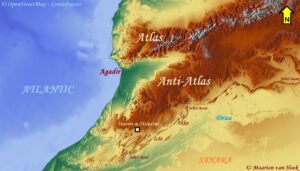
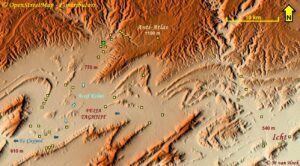
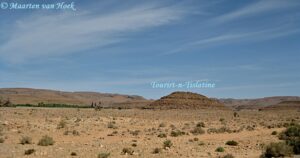
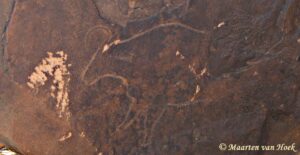
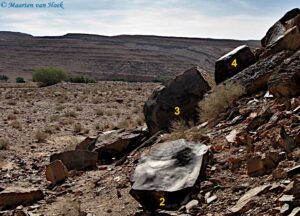
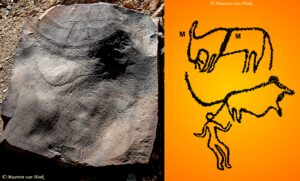
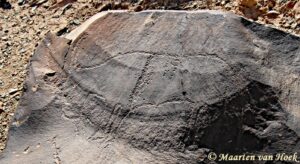
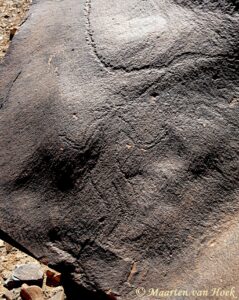
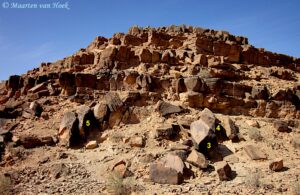
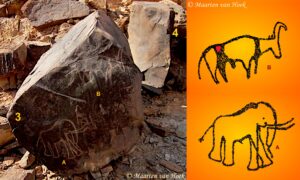
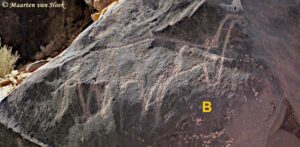
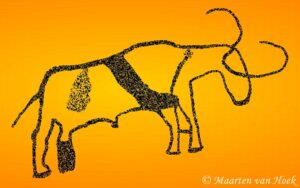
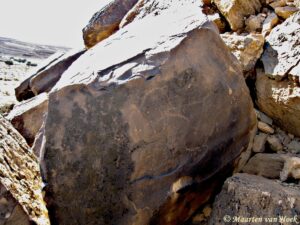
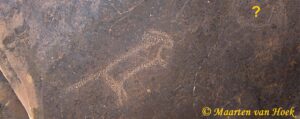
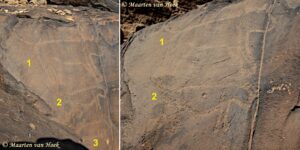
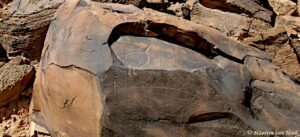
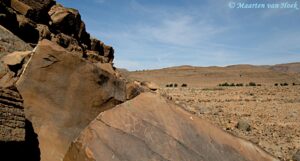
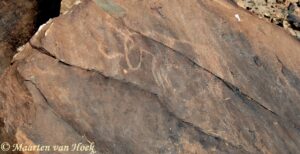
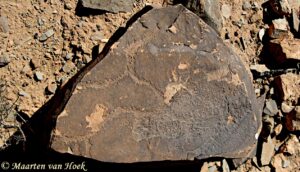














Leave a Reply